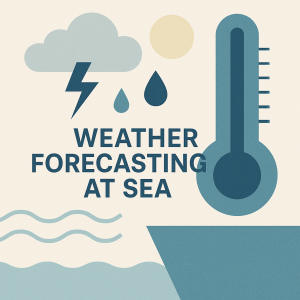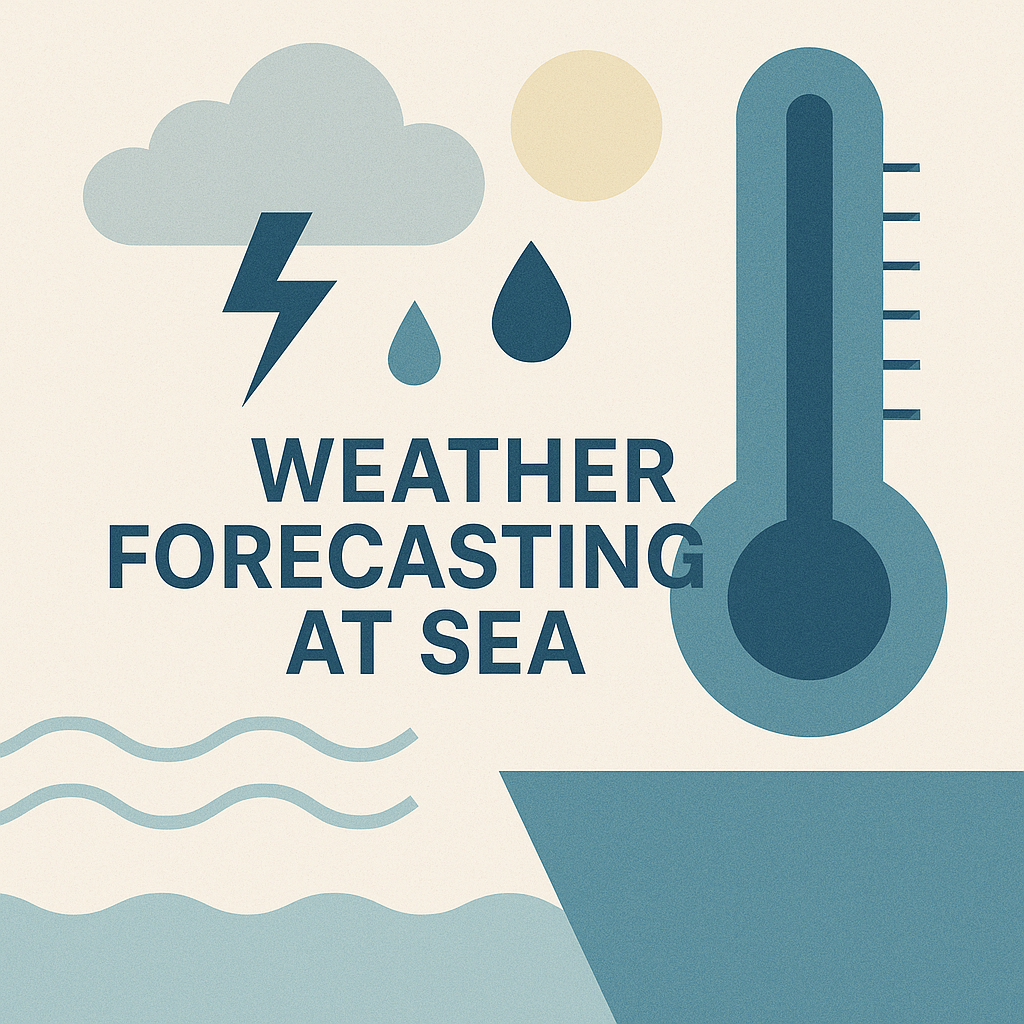 Explore how weather forecasting at sea protects ships, cargo, and crews from nature’s extremes. Learn modern tools, satellite tech, and real-world practices shaping marine weather safety.
Explore how weather forecasting at sea protects ships, cargo, and crews from nature’s extremes. Learn modern tools, satellite tech, and real-world practices shaping marine weather safety.
Weather at sea can turn from calm to catastrophic in a matter of hours. For seafarers, a proper understanding of marine weather forecasting isn’t just helpful—it’s lifesaving. This comprehensive guide explains how weather forecasting at sea works, what tools mariners use, and how recent innovations are improving safety, route planning, and operational efficiency.
Why Weather Forecasting Matters in Modern Maritime Operations
Shipping lanes cross vast and often unpredictable oceans. Storms, swells, cyclones, and even unexpected fog can impact:
- Crew safety
- Cargo condition
- Fuel consumption
- Ship stability
According to the International Maritime Organization (IMO), over 75% of marine accidents involve weather-related factors. The North Atlantic, Indian Ocean monsoon zone, and the South China Sea are notorious for sudden weather changes. In these environments, forecasting isn’t a luxury—it’s a core operational necessity.
Core Principles of Marine Weather Forecasting
Weather forecasting at sea blends science and technology. It uses data from satellites, buoys, onboard sensors, and global meteorological models.
Key elements include:
- Atmospheric pressure: Falling pressure often signals storms.
- Wind patterns: Affect wave height, direction, and ship motion.
- Humidity and temperature: Help predict fog or thunderstorms.
- Ocean currents and sea surface temperatures (SST): Drive cyclone formation and El Niño–La Niña patterns.
Forecasting combines historical data, present measurements, and numerical simulations to predict future conditions over hours or days.
–
Technologies Transforming Weather Forecasting at Sea
Modern marine weather forecasting benefits from multiple sources:
Satellite-Based Observation Systems
Satellites from NOAA, EUMETSAT, and Japan’s Himawari collect real-time sea surface data. They measure wind vectors, wave heights, and cloud patterns. Instruments like scatterometers and altimeters help detect cyclonic activity before it forms.
Weather Routing Software
Tools like SPOS, BonVoyage, and NaviPlanner integrate forecast data with ship performance models. They suggest optimal routes to avoid rough weather while saving fuel—a practice known as weather routing.
Shipboard Weather Instruments
Vessels are equipped with:
- Barometers (pressure measurement)
- Anemometers (wind speed)
- Hygrometers (humidity)
- Radar and weather fax (NAVTEX) receivers
These instruments send data to the bridge and shore stations, improving localized forecasts.
Global Maritime Distress and Safety System (GMDSS)
Under SOLAS Chapter IV, all ships above 300 GT must carry GMDSS-compliant weather equipment. GMDSS distributes:
- Navigational warnings
- Meteorological forecasts
- Search and rescue info
Broadcasts come via Inmarsat-C, HF/MF radio, and SafetyNET.
How Mariners Use Forecasts
Forecasts aren’t just for planning. They directly affect decisions made hour by hour:
- Voyage Planning: Using IMO’s Guidelines for Voyage Planning (Resolution A.893(21)), captains review GRIB files, meteorological charts, and tropical storm updates before departure.
- Onboard Monitoring: Continuous updates allow changes to speed or heading to avoid danger zones. Many large vessels now use automated alerts integrated with ECDIS.
- Emergency Decision-Making: Accurate storm warnings let crews secure loose gear, reduce speed, or alter course. During typhoons or hurricanes, a 12–24 hour warning can be the difference between safety and disaster.
–
Real-World Example: Avoiding Cyclone Mocha in the Bay of Bengal
In May 2023, as Cyclone Mocha intensified in the Bay of Bengal, maritime authorities issued alerts through the Indian Meteorological Department and Inmarsat systems. Using satellite routing software, several container ships rerouted through the western corridor near Sri Lanka, avoiding the storm’s path entirely.
According to BIMCO’s post-event report, no vessels sustained structural damage in that region, a testament to forecasting accuracy and real-time data integration.
–
Recent Developments and Smart Technologies
AI and Machine Learning in Forecasting
Startups and research groups are using AI models to improve accuracy. These tools analyze petabytes of historical data and learn storm behaviors across regions. According to research published in Marine Policy (2023), AI-enhanced models improve forecast accuracy by 20–35% in high-risk zones.
Integrated Bridge Systems (IBS)
Modern ships feature smart bridges integrating weather systems with navigation, propulsion, and autopilot. For example, Wärtsilä’s NaviBridge connects ECDIS, radar, and real-time weather overlays, letting officers see and avoid weather systems dynamically.
Crowdsourced Marine Weather
Platforms like MarineTraffic and SailGrib collect real-time data from thousands of ships, yachts, and fishing vessels. These data supplement global weather models, especially in low-observation areas like the Southern Ocean.
–
Challenges in Marine Weather Forecasting
While technology has improved, challenges remain:
- Data Gaps in Remote Areas: Some oceanic zones lack buoy or shipborne sensors.
- Model Limitations: Long-range forecasts (>5 days) often diverge in accuracy.
- Communication Interruptions: HF and satellite links may fail during geomagnetic storms or equipment outages.
- Interpretation Skills: Not all crew are trained in meteorological chart reading, especially on smaller vessels.
Addressing these gaps requires investment in education, infrastructure, and redundancy in communication systems.
–
The Role of International Regulations
Several IMO and SOLAS provisions regulate marine forecasting:
- SOLAS Chapter V requires ships to carry up-to-date nautical and meteorological charts.
- STCW Convention (Table A-II/1) mandates officer competence in interpreting marine weather forecasts.
- IMO Model Courses like 7.03 and 7.04 cover meteorology in deck officer training.
National authorities like the UK Met Office, NOAA (USA), and Japan Meteorological Agency also publish shipping forecasts and warnings aligned with GMDSS standards.
–
FAQ: Weather Forecasting at Sea
How far in advance can weather forecasts predict storms at sea?
Most oceanic weather systems can be forecasted 3–5 days in advance with reasonable accuracy. For tropical cyclones, early signs may appear 7–10 days before landfall.
What are GRIB files, and why do mariners use them?
GRIB (Gridded Binary) files contain compressed weather data used in marine routing software. They offer wind, pressure, wave, and precipitation layers in small data packets.
Are weather routing services expensive?
Some services are commercial (e.g., StormGeo, SPOS), while others are free (NOAA, MetOffice). Commercial platforms offer ship-specific optimization, which justifies their cost.
How do small vessels receive weather updates offshore?
Through VHF/MF broadcasts (NAVTEX), Inmarsat Mini-C, and apps that use Iridium satellite networks. Sailors often rely on barometers and cloud reading too.
What is the Beaufort Scale used for?
The Beaufort Scale ranks wind intensity from 0 (calm) to 12 (hurricane). It helps mariners assess sea state visually and numerically.
Can ships entirely avoid bad weather?
Not always, but strategic routing minimizes exposure. Slow steaming, heading adjustments, and early planning can reduce risk.
–
Conclusion: Navigating the Weather with Confidence
Weather forecasting at sea is no longer guesswork—it’s a strategic, data-rich science. With satellites, AI, and smart bridges, ships can navigate with foresight rather than fear. Yet the human element remains critical. Training, situational awareness, and prudent seamanship remain as vital as ever.
As climate change increases weather unpredictability, investments in forecasting tools and meteorological education will be essential. The sea will always be powerful, but thanks to innovation, mariners are more empowered than ever to navigate it safely.
References
- IMO. (2023). SOLAS Consolidated Edition
- NOAA. (2024). National Weather Service Marine Forecasts
- BIMCO. (2023). Cyclone Mocha Case Report
- Marine Policy Journal. (2023). “AI in Marine Meteorology.” Elsevier.
- UK Met Office. (2024). Shipping Forecasts
- Inmarsat Maritime. (2024). GMDSS Services
- Wärtsilä. (2023). Smart Bridge Technology
- MarineTraffic. (2024). Crowdsourced Weather Maps
- IMO STCW Code. (2022). Table A-II/1
- The Nautical Institute. (2024). Meteorology for Mariners

